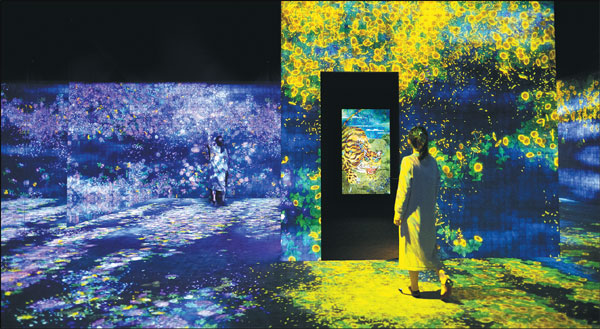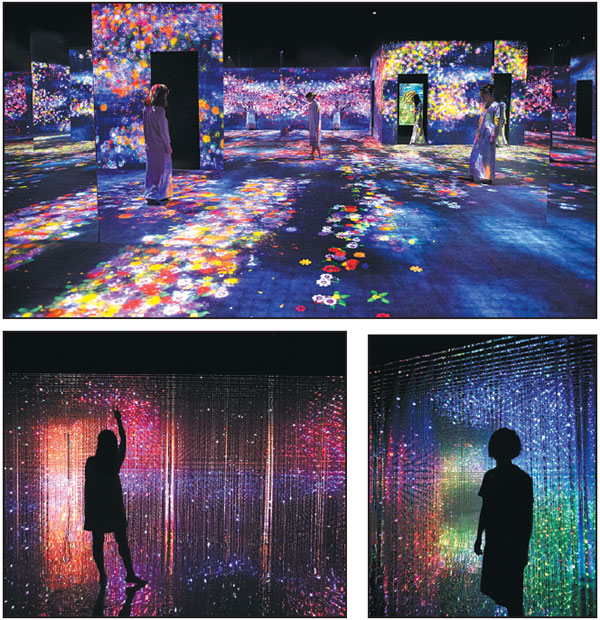Tech art
By Lin Qi (China Daily) Updated: 2017-07-04 07:45Tokyo-based group that brings engineers and artists together for global projects makes China debut with interactive exhibition. Lin Qi reports.
It is one of the largest interdisciplinary art collectives in the world. Since it was founded by Toshiyuki Inoko in Tokyo in 2001, teamLab has gathered some 400 professionals from various fields, including artists, engineers, animators, architects and mathematicians.
Calling themselves "ultra-technologists", they have created installations of light and sound, mixing art and technology that have enthralled the audiences.

|
Visitors experience the interactive digital installations at the show teamLab: Living Digital Forest and Future Park in Beijing. Photos Provided by Teamlab, Pace Beijing and Xian Zhuoyan |
The collective works in groups on different projects around the world.
Their digital installations are now shown at exhibitions in seven cities of different countries, including the China debut exhibition, teamLab: Living Digital Forest and Future Park, at Pace Gallery's space in Beijing.
One is Flower Forest: Lost, Immersed and Reborn, which is taking up the bulk of Pace Beijing's space of 1,500 square meters. The gallery has been associated with them since 2014.
In this work, a computer program renders real-time images of thousands of flowers in the four seasons - blossoming and withering. They are projected on the floor, the walls and panels of mirrors to create a dynamic garden, with the audience actually inside it rather than looking at it from outside.
The work is interactive: When people touch the flowers or "step" on them, the petals fall and fade away.
Another work, also created by them earlier this year, is displayed in a separate room in the Beijing gallery.
Computer-generated images on LED screens surround viewers from all sides, narrating the adventure of eight crows that chase each other, scatter and finally turn into flowers. The music for this work, by Hideaki Takahashi, adds dramatic tension and grandeur to it.
"People have to utilize their bodies and open up their senses to experience the environment of the exhibition. The lives of a flower, a leaf and a crow look splendid but also slightly sad," says Fu Lang, a visitor and a Beijing resident.
"Diverse presentations of the process from glamorous living to a sorrowful death make the installations interesting."
Inoko, who studied science at the University of Tokyo, says the exhibition aims to make the audience feel that time and space have disappeared, by absorbing people into the environment.
He says people have been empowered by advanced technology, and they try to "draw a clear line between them and the world". Such work tends to blur the boundary.
"I hope people can understand that the world is not all about the information they get from media such as TV programs and social networking services. I hope people can feel the world with their minds and bodies," says the 40-year-old artist.
Takashi Kudo, the communications director at teamLab, says technology is not "super important" to their output, although it is the core medium of their work.
He says what matters a lot is the experience of people in finding different ways to communicate with the world.
The digital installations of teamLab have evolved in terms of imagination and technical details, as their previous exhibitions in the United States and Europe have shown.
The collective is among international groups whose interdisciplinary endeavors have created immersive environment at exhibitions and reshaped people's viewing experiences. And, some such works have been introduced to the Chinese audience in recent times.
"We believe teamLab represents an important development in contemporary art. They work as an art collective. Their media is technology in the form of digital language," says Peter Boris, executive vice-president of Pace Gallery who presented the first teamLab exhibition at Pace in New York three years ago.
"Like every serious artist of every age, their goal is to discover and then to express the living reality of its time."
Boris currently works to develop Pace Art + Technology, a program in collaboration with interdisciplinary art groups to explore the confluence of art and technology. The program involves Random International, a 20-person team in London and Berlin acclaimed for the large-scale, location-specific installation, Rain Room.
The work creates an environment of torrential rain and it will stop falling when it detects people walking into it. Its first Asian show was held in Shanghai in 2015.
Shanghai also held James Turrell: Immersive Light from January to May, the China debut of the prominent US artist whose light installations left the audience wondering about different perceptions.
But the rise in such immersive shows has also led to discussions on whether they can be viewed as art.
Xian Zhuoheng, a visitor in Beijing who frequents contemporary art shows, says technology and interdisciplinary efforts have enriched the definition of "artwork".
"Immersive work, like other forms of art, is a presentation based on individual experience of artists. It's vivid, interactive and brings art closer to people. And it doesn't lack in depth of expression."
Boris from Pace says the current exhibition marks "the close of a cycle of growth for teamLab" and it gives people the clues to the future of their works.
Inoko says his team wants to create an even bigger work - turning a part of a city or natural environment into an exhibition space to display their works.
Contact the writer at linqi@chinadaily.com.cn
- 'Cooperation is complementary'
- Worldwide manhunt nets 50th fugitive
- China-Japan meet seeks cooperation
- Agency ensuring natural gas supply
- Global manhunt sees China catch its 50th fugitive
- Call for 'Red Boat Spirit' a noble goal, official says
- China 'open to world' of foreign talent
- Free trade studies agreed on as Li meets with Canadian PM Trudeau
- Emojis on austerity rules from top anti-graft authority go viral
- Xi: All aboard internet express












